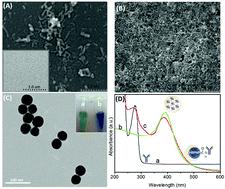Our official English website, www.x-mol.net, welcomes your
feedback! (Note: you will need to create a separate account there.)
In situ amplified QCM immunoassay for carcinoembryonic antigen with colorectal cancer using horseradish peroxidase nanospheres and enzymatic biocatalytic precipitation.
Analyst ( IF 3.6 ) Pub Date : 2020-07-31 , DOI: 10.1039/d0an01399d Liangjie Chi 1 , Chao Xu , Shuyuan Li , Xiangyu Wang , Dianping Tang , Fangqin Xue
Analyst ( IF 3.6 ) Pub Date : 2020-07-31 , DOI: 10.1039/d0an01399d Liangjie Chi 1 , Chao Xu , Shuyuan Li , Xiangyu Wang , Dianping Tang , Fangqin Xue
Affiliation

|
Methods based on enzyme labels or nano labels have been developed for immunoassays, but most of them have low sensitivity and are unsuitable for low-abundance protein diagnostics and biosecurity. Herein, an innovative quartz crystal microbalance (QCM) immunosensing method was designed for high-efficiency detection of carcinoembryonic antigen (CEA) from serum samples with colorectal cancer patients by using horseradish peroxidase (HRP) nanoparticles as the enhancer, accompanying enzymatic biocatalytic precipitation (EBCP) toward 4-chloro-1-naphthol (4-CN) on an anti-CEA capture antibody-conjugated QCM probe. Initially, HRP nanospheres were synthesized on the basis of the reverse micelle method with the assistance of glutaraldehyde cross-linking, and then covalently conjugated onto polyclonal anti-CEA detection antibodies. The QCM immunosensing probe was prepared by immobilizing monoclonal anti-CEA capture antibodies on an L-cysteine-modified gold substrate. In the presence of target CEA, a sandwich-type immunoreaction was carried out between capture antibody and detection antibody, thereby resulting in the attachment of HRP nanospheres on the gold probe. Upon addition of 4-CN in the QCM cell, the carried HRP nanospheres catalyzed the 4-CN oxidation to produce an insoluble precipitate on the gold electrode, thus causing a change in the frequency. Relative to the conventional HRP-labeled strategy and direct antigen–antibody reaction, improved analytical features were obtained with HRP nanospheres. With the HRP nanosphere labeling method, the factors influencing the performance of the immunoassay were also studied. The covalent conjugation of antibodies with HRP nanospheres and the gold substrate achieved a good repeatability and intermediate precision down to 10.7%. Under optimum conditions, the frequency variation of the QCM immunoassay was proportional to the target CEA concentration within a dynamic linear range of 0.01–100 ng mL−1 with a detection limit (LOD) of 7.8 pg mL−1. In addition, the developed QCM immunoassay showed high specificity and long-term storage stability, and could be used for the analysis of human serum samples with consistent results in comparison with those obtained from the commercial enzyme-linked immunosorbent assay (ELISA) method.
中文翻译:

使用辣根过氧化物酶纳米球和酶促生物催化沉淀法原位扩增QCM免疫测定大肠癌的癌胚抗原。
已经开发了基于酶标记或纳米标记的方法用于免疫测定,但是大多数方法灵敏度低,不适合用于低丰度蛋白质诊断和生物安全性。本文设计了一种创新的石英晶体微天平(QCM)免疫传感方法,以辣根过氧化物酶(HRP)纳米粒子为增强剂,并伴随酶促生物催化沉淀(EBCP),可有效检测大肠癌患者血清中的癌胚抗原(CEA) )在抗CEA捕获抗体偶联的QCM探针上朝向4-氯-1-萘酚(4-CN)。最初,在戊二醛交联的帮助下,根据反胶束法合成了HRP纳米球,然后将其共价缀合到多克隆抗CEA检测抗体上。大号-半胱氨酸修饰的金底物。在目标CEA存在的情况下,在捕获抗体和检测抗体之间进行了夹心型免疫反应,从而导致HRP纳米球附着在金探针上。在QCM电池中添加4-CN后,携带的HRP纳米球催化4-CN氧化,从而在金电极上产生不溶性沉淀,从而引起频率变化。相对于传统的HRP标记策略和直接的抗原抗体反应,HRP纳米球的分析特性得到了改善。使用HRP纳米球标记方法,还研究了影响免疫测定性能的因素。抗体与HRP纳米球和金底物的共价缀合实现了良好的重复性和低至10.7%的中间精度。-1的检测极限(LOD)为7.8 pg mL -1。此外,已开发的QCM免疫测定法具有很高的特异性和长期储存稳定性,与从商业化酶联免疫吸附测定法(ELISA)获得的结果相比,可用于分析人血清样品,具有一致的结果。
更新日期:2020-09-14
中文翻译:

使用辣根过氧化物酶纳米球和酶促生物催化沉淀法原位扩增QCM免疫测定大肠癌的癌胚抗原。
已经开发了基于酶标记或纳米标记的方法用于免疫测定,但是大多数方法灵敏度低,不适合用于低丰度蛋白质诊断和生物安全性。本文设计了一种创新的石英晶体微天平(QCM)免疫传感方法,以辣根过氧化物酶(HRP)纳米粒子为增强剂,并伴随酶促生物催化沉淀(EBCP),可有效检测大肠癌患者血清中的癌胚抗原(CEA) )在抗CEA捕获抗体偶联的QCM探针上朝向4-氯-1-萘酚(4-CN)。最初,在戊二醛交联的帮助下,根据反胶束法合成了HRP纳米球,然后将其共价缀合到多克隆抗CEA检测抗体上。大号-半胱氨酸修饰的金底物。在目标CEA存在的情况下,在捕获抗体和检测抗体之间进行了夹心型免疫反应,从而导致HRP纳米球附着在金探针上。在QCM电池中添加4-CN后,携带的HRP纳米球催化4-CN氧化,从而在金电极上产生不溶性沉淀,从而引起频率变化。相对于传统的HRP标记策略和直接的抗原抗体反应,HRP纳米球的分析特性得到了改善。使用HRP纳米球标记方法,还研究了影响免疫测定性能的因素。抗体与HRP纳米球和金底物的共价缀合实现了良好的重复性和低至10.7%的中间精度。-1的检测极限(LOD)为7.8 pg mL -1。此外,已开发的QCM免疫测定法具有很高的特异性和长期储存稳定性,与从商业化酶联免疫吸附测定法(ELISA)获得的结果相比,可用于分析人血清样品,具有一致的结果。









































 京公网安备 11010802027423号
京公网安备 11010802027423号